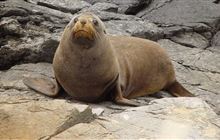DOC calls for sightings of our subantarctic neighbours
Archived content: This media release was accurate on the date of publication.
Introduction
A potential increase in sightings of subantarctic fur seals has DOC scientists asking members of the public to report any sightings of these long-distance travellers.Date: 06 September 2021
Subantarctic fur seals are “cousins” of the native kekeno/New Zealand fur seal. They appear similar but have some obvious differences which make identification easy.
“The key signs to look for are a blunter/shorter nose and creamy-coloured fur on the throat and underside,” says Laura Boren, Technical Advisor at DOC.
“NZ fur seals will appear grey or brown and much more uniform in colour, while the subantarctic variety have very two-tone colouration with the distinctive pale cream underneath.”
“Of course, the best way to confirm the species is to take a photo – from a few different angles if possible.”
Subantarctic fur seals are found typically on offshore islands throughout the subantarctic region including the southern Indian Ocean and southern Atlantic. While it is rare, they do occasionally make their way to Aotearoa.
In July 2021, a dead pup washed up at Kairakau Beach in Hawkes Bay. The pup had been tagged on Amsterdam Island in the Indian Ocean in September 2020, meaning it swam well over 8,000 km to arrive here. At approximately 1.5 years old, it is probable that it died of starvation.
“It’s tough for a young seal to make such a long journey. Many don’t end up surviving because they have usually used all their energy getting here. The luckier ones find plenty of food along the way and will turn up in good condition.”
While it’s sad to find a dead pup, reporting the sighting is still useful, says Laura. “This has allowed us to contribute valuable information to the French Subantarctic Programme, which manages Amsterdam Island.”
Recent sightings of other subantarctic seal pups near Auckland, Rangitoto Island, and Whangamata have DOC staff wondering if they might be coming to our shores more frequently.
“It’s too early to say if we’re seeing a trend,” says Laura, “We need more information. Keep your eyes peeled and call our hotline 0800 DOC HOT (0800 362 468) if you spot one. If you can get photos to help with identification please do. Remember to use your zoom and keep your distance as these visitors need to rest up after their marathon swim.”
Background information
While it is possible that adult subantarctic fur seals may be spotted, most ones seen in New Zealand are pups and juveniles.
If you are lucky enough to see an adult the noses are still short and blunt, and they still have the lighter colouration on the underside, though the difference in the two-toned colour is less pronounced in the female. The males, however, are very noticeable for they have a unique ‘fur-style’ resembling a mohawk.
If you encounter a seal on or near a beach, please give it space.
- Always keep dogs on a leash, under control and away from seals
- Ensure you keep small children at a safe distance and under your control when watching seals
- Don’t get closer than 20 metres
- Do not get between the seal and the sea
- Do not touch or feed the seal.
Never touch or handle a seal – they are wild animals and can be very aggressive if threatened. It is also a breach of the Marine Mammals Protection Act. Keep a distance of at least 20 metres from seals, if possible, and do not get between the seal and the sea.
If you are walking your dog in areas where seals regularly haul-out, or see a seal on your beach, put your dog on-lead until you are away from the seal.
If you see a seal which is severely injured, being harassed, or in obvious danger, call 0800 DOC HOT (0800 362 468).
Contact
For media enquiries contact:
Email: media@doc.govt.nz

